Family : Serranidae

Text © Giuseppe Mazza

English translation by Mario Beltramini
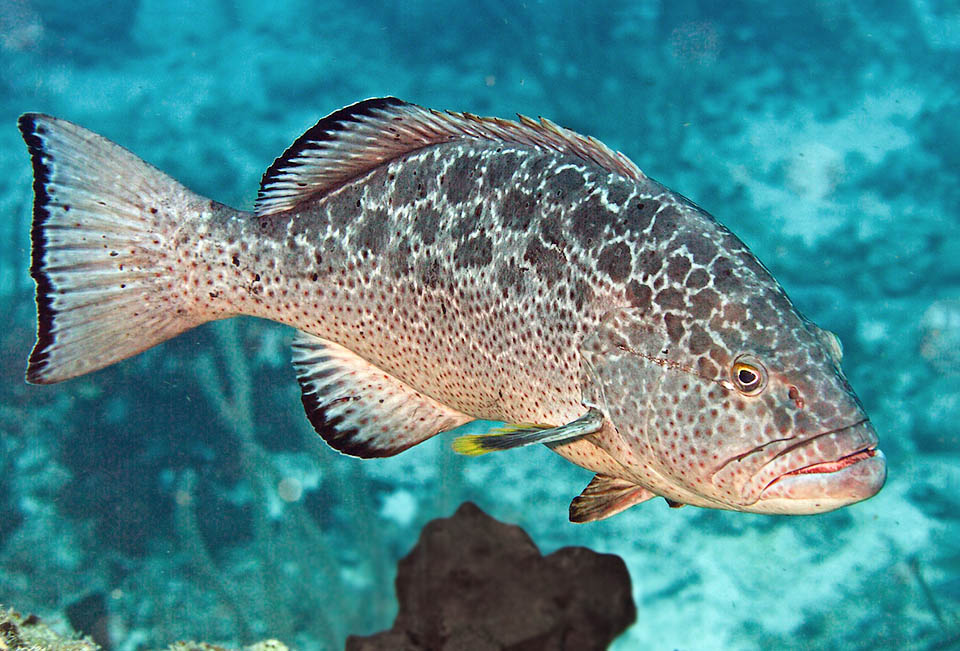
Usually 45 cm long, the Yellowfin grouper (Mycteroperca venenosa) is present in western Atlantic tropical and subtropical waters from the Bermudas to Brazil © Allison & Carlos Estape
Known as Yellowfin grouper due to the golden zone always present at the extremities of the pectoral fins,
Mycteroperca venenosa (Linnaeus, 1758) belongs to the class of the Actinopterygii, the ray-finned fishes, to the order of the Perciformes and to the family of the Serranidae, subfamily Epinephelinae.
The genus Mycteroperca created by Gill in 1862 originates from “mycterus”, nostril, with reference to the conspicuous rear nostrils, almost twice as large as the front ones, and from “perca”, name used since the ancient times and resumed by Linnaeus for the perch, fish to which roughly resembles.
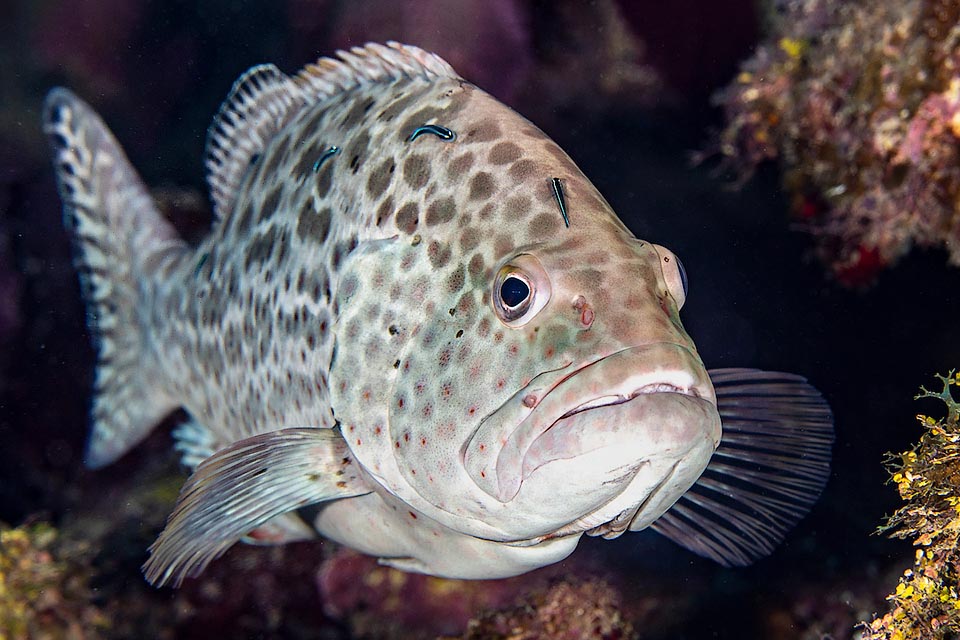
Here entering a cleaning station where the big fishes go peacefully to get cleaned from the skin parasites by the small Sharknose goby (Elacatinus evelynae) © Allison & Carlos Estape
The specific term venenosa, venomous in Latin, reminds us that quite often the flesh of this grouper is at risk of ciguatera, a serious food poisoning frequent in the Caribbean with the species eating fishes that have stored in their tissues the toxin produced by the dinoflagellate Gambierdiscus toxicus.
Zoogeography
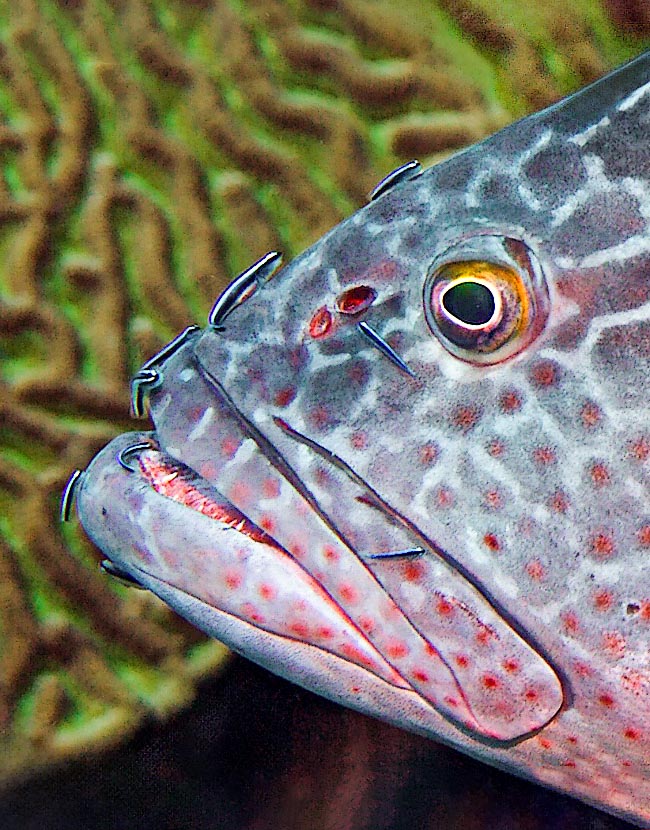
A chance to observe it closely. The back nostril is much bigger than the other, as the scientific name of the genus recalls, the lower jaw is longer and the numerous sharp canines are little protruding © Allison & Carlos Estape
Mycteroperca venenosa lives in the western Atlantic ocean, from the Bermudas and the Gulf of Mexico to the Caribbean and then, southwards, in Venezuela and in Brazil, up to São Paulo.
Ecology-Habitat
The adults are normally found in madreporic or rocky environments between 5 and 35 m of depth, but go swimming also in 2 m of water and can go down up to and beyond 100 m with a sighting reported at 137 m.
The juveniles usually grow in the submerged prairies of Thalassia testudinum, a phanerogam frequent in the Caribbean and known as Turtlegrass because it is often grazed, besides the herbivorous fishes, by these big reptiles.
A habitat rich in mollusks, crustaceans and small fishes where the young groupers find food and shelter.
Also when an adult, Mycteroperca venenosa is a shy grouper who feels the need to hide.
The position of the den, usually in grottoes or in wrecks, is not in fact chosen because it is favourable for predation, but because it is a safe place.
Morphophysiology
The Yellowfin grouper can reach the length of 1 m, with a published maximum weight of 18,5 kg, but the current size is about 45 cm.
The central part of the body, elongated and compressed, is almost rectangular with the same height between the first part of the dorsal fin and the beginning of the anal.
The snout greatly exceeds the diametre of the eye and the big mouth, that opens suddenly for sucking in the prey alive, presents fleshy lips with a longer lower jaw.
Several sharp canines, not very prominent, serve to hold those that were not swallowed at the first try.
The preoperculum is rounded with slight indentations at the base without a prominent bony lobe at the corner.
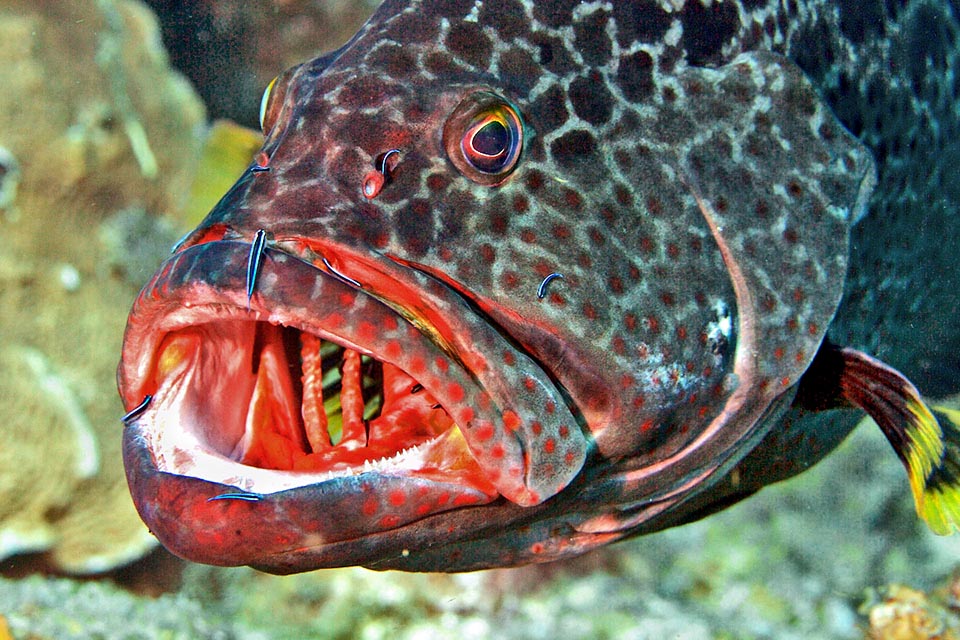
They serve to hold the big preys that are not swallowed immediately. Like all groupers, in fact, it sucks the whole fishes, opening suddenly the huge mouth © Allison & Carlos Estape
The ctenoid scales, present also at the base of the dorsal fin and of the anal are rough in the juveniles and smooth in the adults who have small auxiliary scales.
They are much more numerous on the body, with rows of 60-146 elements, whilst the lateral line has 72 to 81 scales.
The dorsal fin has 11 spiny rays and 15-16 soft ones; the anal 3 spiny rays and 10-12 unarmed; the pelvic ones do not have spines and the pectorals count 16-18 soft rays.
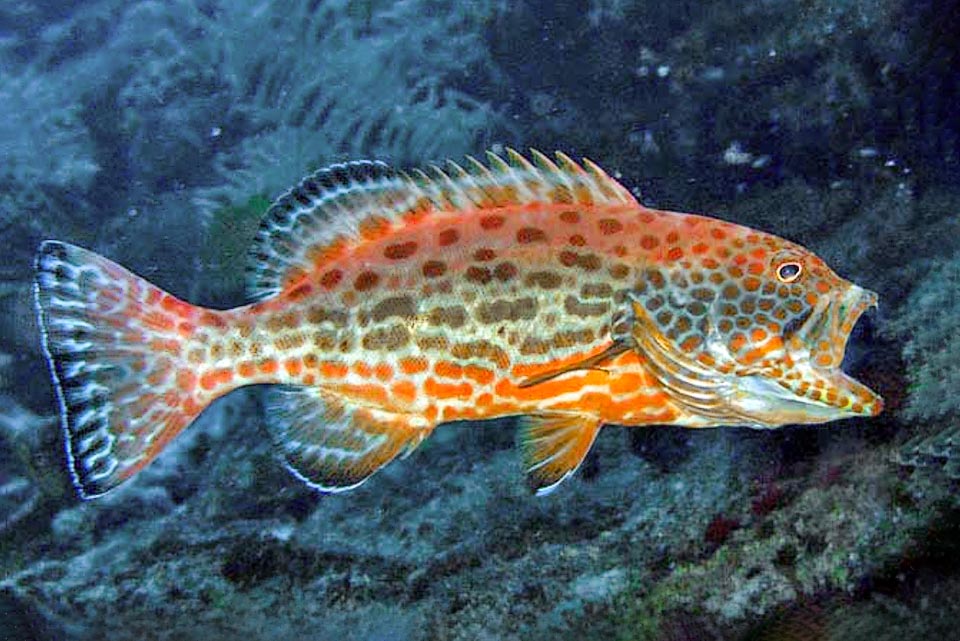
Here, jaws wide open. The first part of the dorsal, often bent, has 11 spiny rays. Between the beginning of this and the anal the profile looks square, with the same height © Mickey Charteris
The caudal fin is more or less truncated, as usually is the case in the groupers.
The livery of Mycteroperca venenosa, extremely variable due to the chromatophores, tends to be greenish for the fishes living in shallow waters and reddish for those moving in deep ones.
The body is dotted with dark oval spots more or less aligned, mostly black above and red on the ventral side.
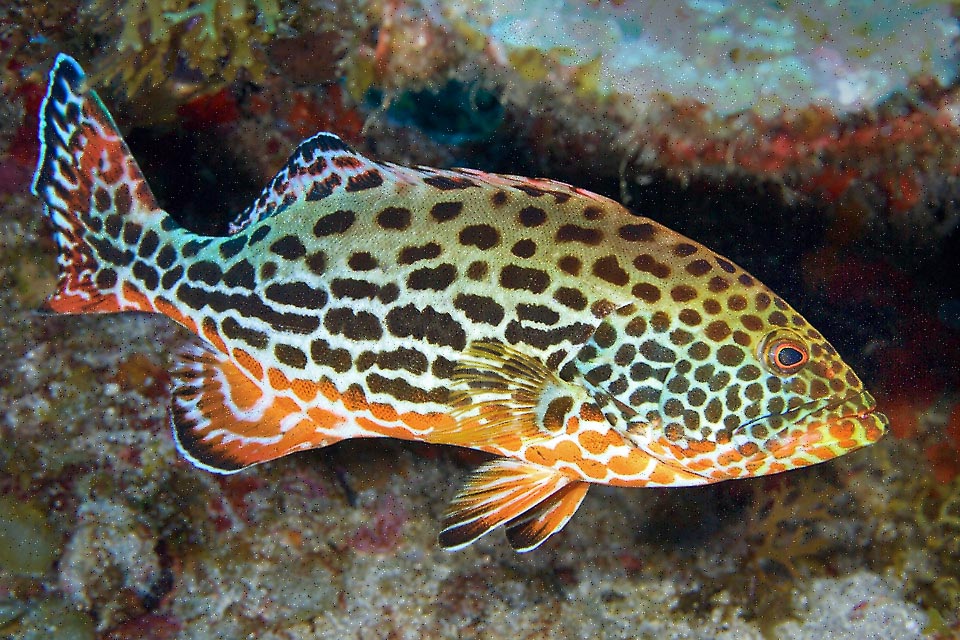
The mimetic livery varies fast depending on circumstances, but often appears with dark oval spots, vaguely aligned, black over and red on the ventral side © Allison & Carlos Estape
But all these drawings may disappear in a moment and the fish may become uniformly light grey above and almost white ventrally and even all black, livery usually adopted when scared and wishing to hide.
A slight sexual dimorphism is present.
The males, bigger, distinguish for the yellow spot on the lower jaw that, conversely, is reddish in the females.
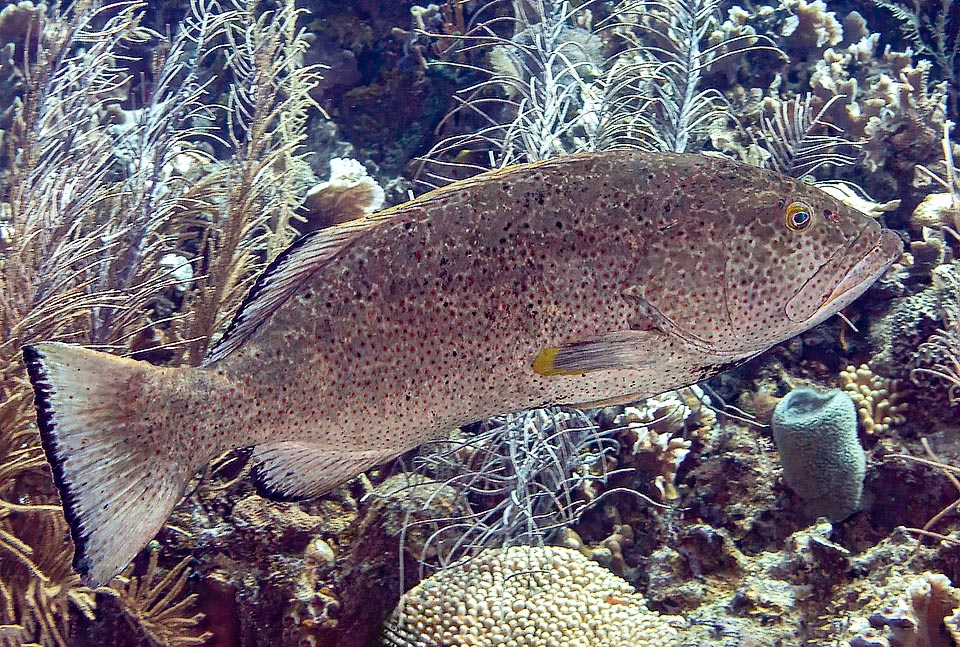
However at times drawings disappear almost totally, and the fish may look dark greyish brown like this one © Allison & Carlos Estape
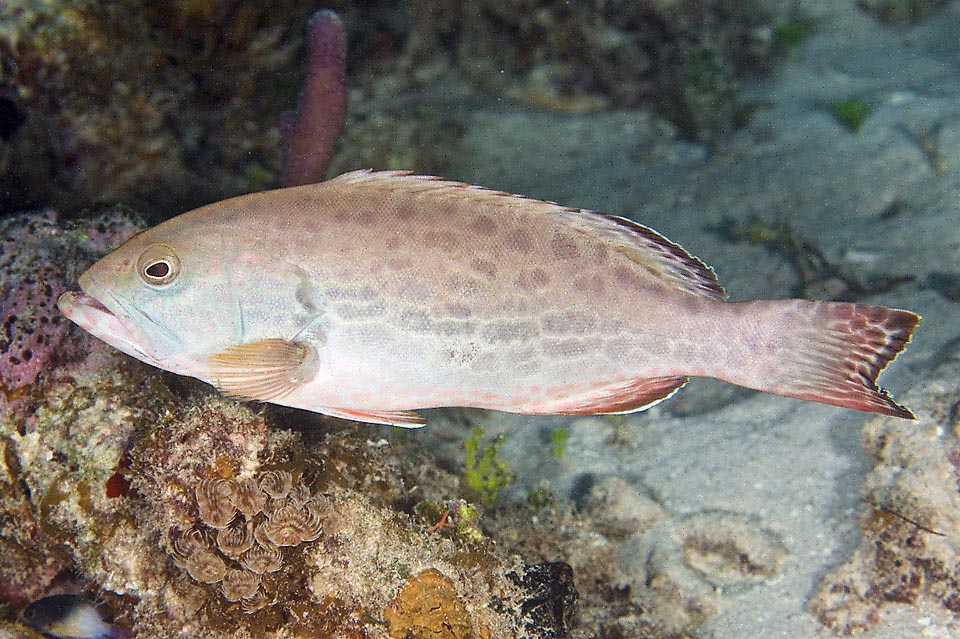
But conversely, especially in shallow waters, it may look pale and dull tending white towards the belly © Allison & Carlos Estape
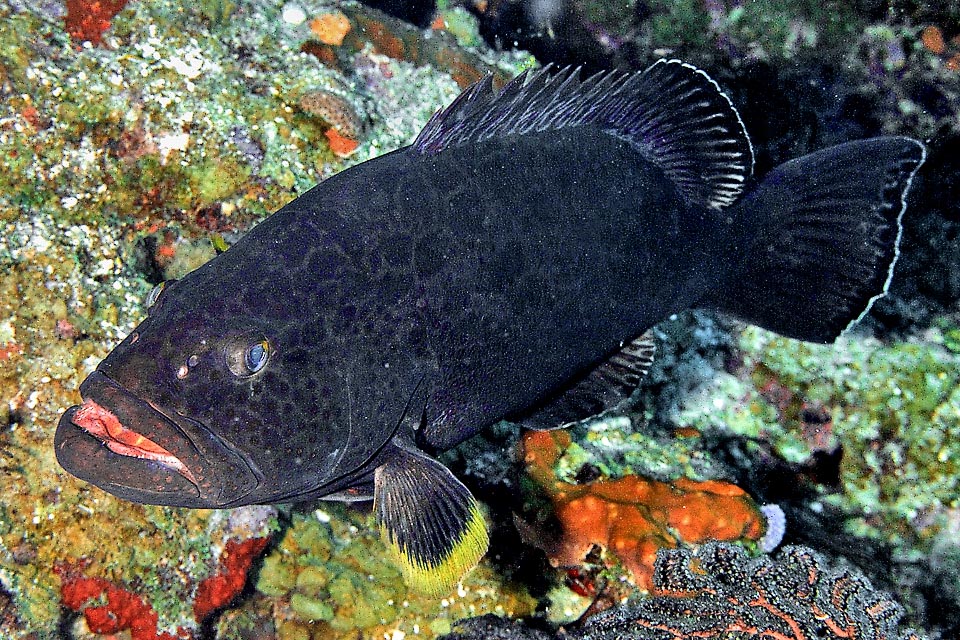
Chromatophores are miraculous and when the grouper is scared and looks for a shelter displays even a black livery to escape predators gaze © Allison & Carlos Estape
For the reproduction or for sending messages to the conspecifics the head can become very clear on the dark body, but in all these versions the yellow part of the pectorals, more or less bright, keeps however always visible.
Ethology-Reproductive Biology
Mycteroperca venenosa is a protogynous hermaphroditic species, with females that reach sexual maturity when about half a metre long and an age of 4-5 years, and may turn into males when 8-9 years old and with 65-80 cm of size.
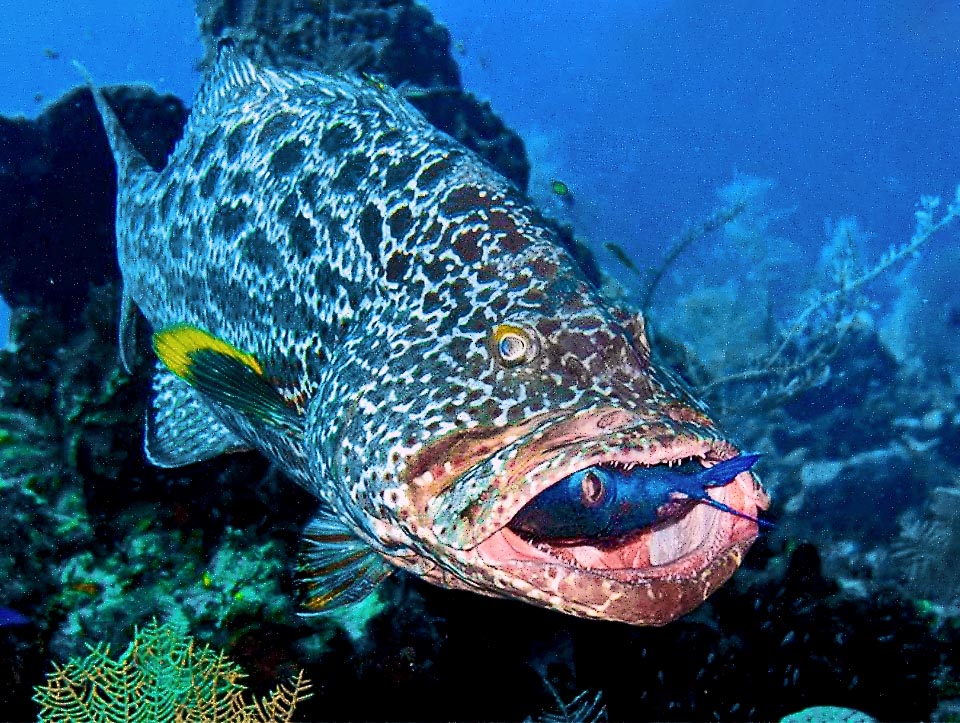
Instead this is a happy Yellowfin grouper as it has just seized a reluctant Acanthurus. Mycteroperca venenosa feeds per 90% of fishes and is preyed upon in turn by the big sharks and the fishermen. In fact its flesh is excellent, but as the specific name reminds in some sites may aver venomous, because at ciguatera risk © Mickey Charteris
The Yellowfin grouper feeds 90% on fishes, but also on squids and, if not caught or devoured by the sharks like Carcharhinus perezii, Galeocerdo cuvier or Negaprion brevirostris, may live even more than 15 years, after some, 30. The juveniles are unfortunately predated by ill-famed Pterois volitans incautiously introduced in the Caribbean.
The Yellowfin grouper lives solitary, but for the reproduction, that usually occurs in winter, take form more or less important aggregations. They can even count hundreds of individuals and in several sites, known to fishermen, often take place, like for the Nassau grouper (Epinephelus striatus) massacres of adults.
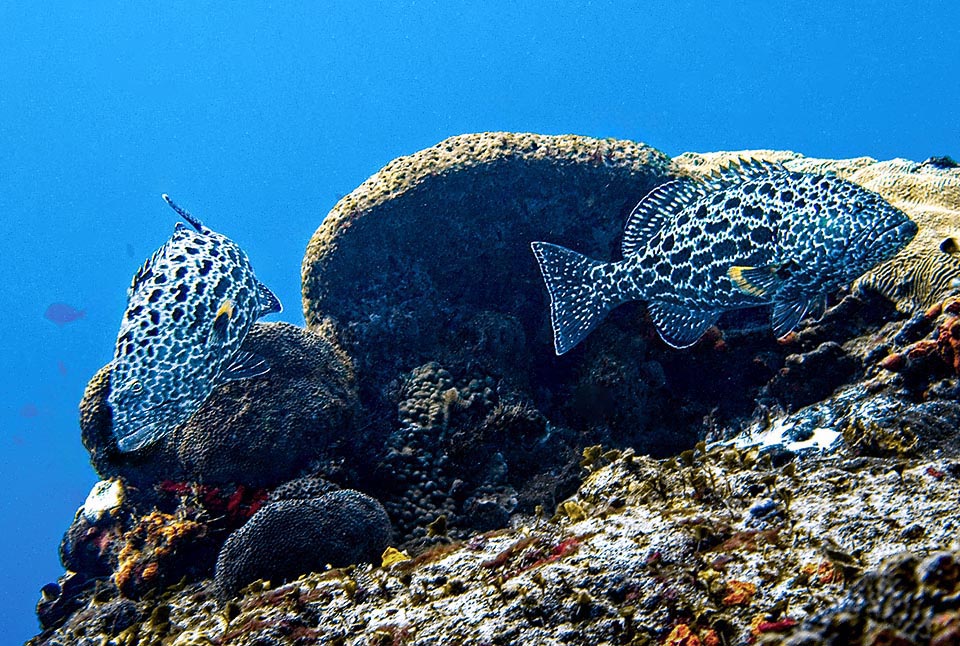
Usually Yellowfin grouper lives alone but in reproductive time more or less important gatherings may form that can count even hundreds of individuals © Matteo Cassella
One of the most known sites is the Grammanik Bank, a narrow shelf about 100 m long at a depth of 25 m, located south of St. Thomas in the British Virgin Islands.
The gathering usually occurs a few days after the full moon. The white headed males emit low frequency sounds to get noticed by the females and the fecundation takes place on the surface.
The eggs, entrusted to the currents, hatch after 24 hours and the planktonic larvae reach the bottoms one week after their birth or after two months depending on the place.
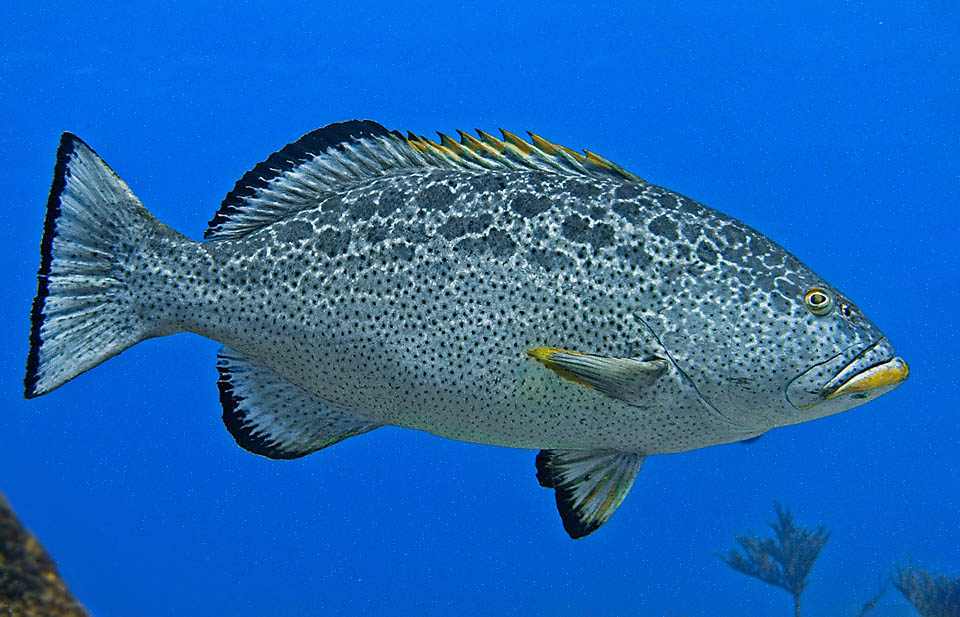
Being a protogynous hermaphroditic species the males are older and hence always bigger than females. They can be recognized at sight for the yellow spot on the lower jaw. In the reproductive gatherings their body darkens whilst the head may turn almost white while they emit low frequency sounds to invite the females to spawn © Matteo Cassella
The fry tend to be red with clear spots that get darker over time.
The resilience of Mycteroperca venenosa is low, with a minimum time for doubling the populations of 4,5-15 years.
The fishing vulnerability,high, marks 62 on a scale of 100, and the populations are marked decline with a global loss of at least 30% of their members from 1980 up to nowadays.
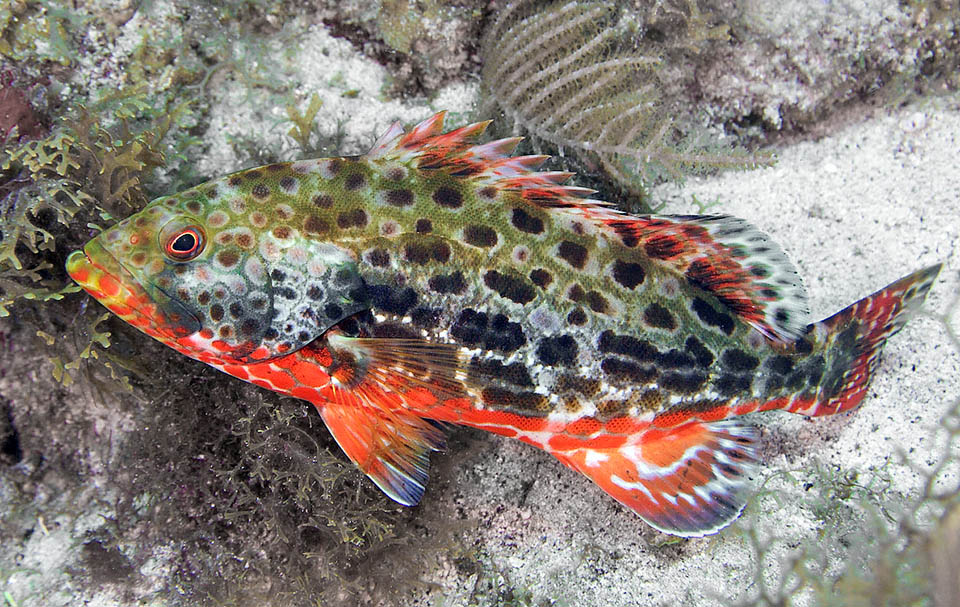
The planktonic eggs hatch after 24 hours and the larvae reach the bottoms after one week or two months depending on the place. This, now grown up, is a subadult © Allison & Carlos Estape
Consequently, the species appears as “NT, Near Threatened” in the IUCN Red List of the endangered species.
Synonyms
Bonaci cardenal Parra, 1787; Perca venenosa Linnaeus, 1758; Trisotropis venenosus (Linnaeus, 1758); Bodianus apua Bloch, 1790; Johnius guttatus Bloch & Schneider, 1801; Bodianus marginatus Bloch & Schneider, 1801; Serranus cardinalis Valenciennes, 1828; Serranus rupestris Valenciennes, 1833; Serranus petrosus Poey, 1860; Mycteroperca bowersi Evermann & Marsh, 1900.
→ For general information about FISH please click here.
→ For general information about BONY FISH please click here
→ For general information about CARTILAGINOUS FISH please click here.
→ To appreciate the BIODIVERSITY of BONY FISH please click here.
→ To appreciate the BIODIVERSITY of CARTILAGINOUS FISH please click here.
